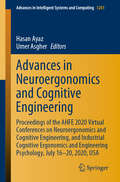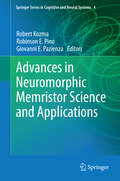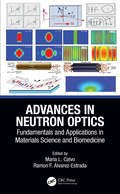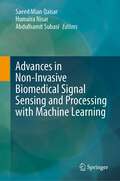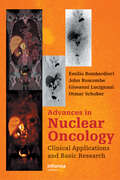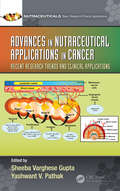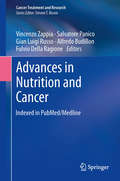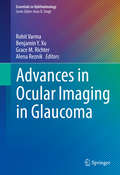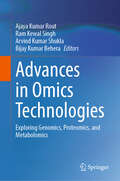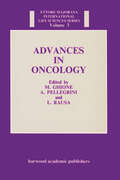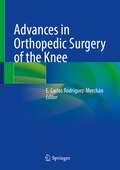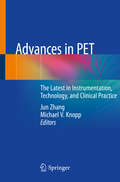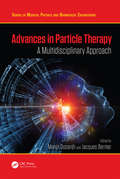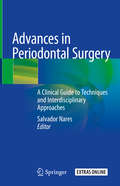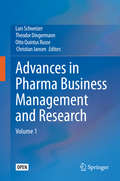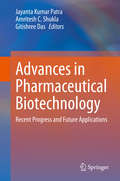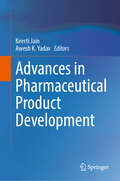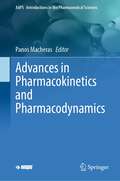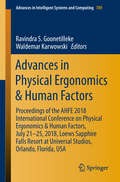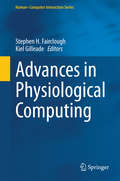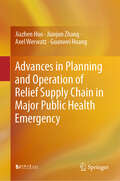- Table View
- List View
Advances in Neuroergonomics and Cognitive Engineering: Proceedings of the AHFE 2020 Virtual Conferences on Neuroergonomics and Cognitive Engineering, and Industrial Cognitive Ergonomics and Engineering Psychology, July 16-20, 2020, USA (Advances in Intelligent Systems and Computing #1201)
by Hasan Ayaz Umer AsgherThis book offers broad overview of the field of cognitive engineering and neuroergonomics, covering emerging practices and future trends toward the harmonious integration of human operators and computer systems. It presents novel theoretical findings on mental workload and stress, activity theory, human reliability, error and risk, and a wealth of cutting-edge applications, such as strategies to make assistive technologies more user-oriented. Further, the book describes key advances in our understanding of cognitive processes, including mechanisms of perception, memory, reasoning, and motor response, with a particular focus on their role in interactions between humans and other elements of computer-based systems. Gathering the proceedings of the AHFE 2020 Virtual Conferences on Neuroergonomics and Cognitive Engineering, and Industrial Cognitive Ergonomics and Engineering Psychology, held on 16–20 July 2020, this book provides extensive and timely information for human–computer interaction researchers, human factors engineers and interaction designers, as well as decision-makers.
Advances in Neuroergonomics and Cognitive Engineering: Proceedings of the AHFE 2021 Virtual Conferences on Neuroergonomics and Cognitive Engineering, Industrial Cognitive Ergonomics and Engineering Psychology, and Cognitive Computing and Internet of Things, July 25-29, 2021, USA (Lecture Notes in Networks and Systems #259)
by Hasan Ayaz Umer Asgher Lucas PalettaThis book offers a broad overview of the field of cognitive engineering and neuroergonomics, covering emerging practices and future trends toward the harmonious integration of human operators and computational systems. It gathers both theoretical and practice-oriented studies on mental workload and stress, activity theory, human reliability, error and risk. It covers applications in various field, and corresponding strategies to make assistive technologies more user-oriented. Further, the book describes key advances in our understanding of cognitive processes, including mechanisms of perception, memory, reasoning, and motor response, with a particular focus on their role in interactions between humans and other elements of computer-based systems. Gathering the proceedings of the AHFE 2021 Conferences on Neuroergonomics and Cognitive Engineering, Industrial Cognitive Ergonomics and Engineering Psychology, and Cognitive Computing and Internet of Things, held virtually on July 25-29, 2021, from USA, this book offers extensive information and a thought-provoking guide for researchers and practitioners in cognitive engineering, neuroergonomics and their applications.
Advances in Neuromorphic Memristor Science and Applications (Springer Series in Cognitive and Neural Systems #4)
by Robinson E. Pino Robert Kozma Giovanni E. PazienzaPhysical implementation of the memristor at industrial scale sparked the interest from various disciplines, ranging from physics, nanotechnology, electrical engineering, neuroscience, to intelligent robotics. As any promising new technology, it has raised hopes and questions; it is an extremely challenging task to live up to the high expectations and to devise revolutionary and feasible future applications for memristive devices. The possibility of gathering prominent scientists in the heart of the Silicon Valley given by the 2011 International Joint Conference on Neural Networks held in San Jose, CA, has offered us the unique opportunity of organizing a series of special events on the present status and future perspectives in neuromorphic memristor science. This book presents a selection of the remarkable contributions given by the leaders of the field and it may serve as inspiration and future reference to all researchers that want to explore the extraordinary possibilities given by this revolutionary concept.
Advances in Neutron Optics: Fundamentals and Applications in Materials Science and Biomedicine (Multidisciplinary and Applied Optics)
by Maria L. Calvo Ramon F. Alvarez-EstradaNeutron optics studies the interactions of a beam of slow neutrons with matter. This book updates various advances on neutron optics. There will be a focus on the very active topics of neutron imaging (NI) and neutron spin optics (NSO). The book will also present applications of neutron beams in biomedicine, such as Boron Neutron Capture Therapy (BNCT) and related techniques. Features: Discusses diffraction and interference of slow neutrons, including computational approaches Reviews neutron imaging (NI) and neutron spin optics (NSO) Treats two major sources of slow neutron beams: (1) fission reactions at nuclear reactors and (2) collisions in particle accelerators (small ones, spallation sources) of charged particle beams with targets of heavy atoms Selects subjects on fundamental quantum aspects of slow neutrons and on confined propagation and waveguiding thereof Updates slow neutron beams and BNCT
Advances in Non-Invasive Biomedical Signal Sensing and Processing with Machine Learning
by Abdulhamit Subasi Saeed Mian Qaisar Humaira NisarThis book presents the modern technological advancements and revolutions in the biomedical sector. Progress in the contemporary sensing, Internet of Things (IoT) and machine learning algorithms and architectures have introduced new approaches in the mobile healthcare. A continuous observation of patients with critical health situation is required. It allows monitoring of their health status during daily life activities such as during sports, walking and sleeping. It is realizable by intelligently hybridizing the modern IoT framework, wireless biomedical implants and cloud computing. Such solutions are currently under development and in testing phases by healthcare and governmental institutions, research laboratories and biomedical companies. The biomedical signals such as electrocardiogram (ECG), electroencephalogram (EEG), Electromyography (EMG), phonocardiogram (PCG), Chronic Obstructive Pulmonary (COP), Electrooculography (EoG), photoplethysmography (PPG), and image modalities such as positron emission tomography (PET), magnetic resonance imaging (MRI) and computerized tomography (CT) are non-invasively acquired, measured, and processed via the biomedical sensors and gadgets. These signals and images represent the activities and conditions of human cardiovascular, neural, vision and cerebral systems. Multi-channel sensing of these signals and images with an appropriate granularity is required for an effective monitoring and diagnosis. It renders a big volume of data and its analysis is not feasible manually. Therefore, automated healthcare systems are in the process of evolution. These systems are mainly based on biomedical signal and image acquisition and sensing, preconditioning, features extraction and classification stages. The contemporary biomedical signal sensing, preconditioning, features extraction and intelligent machine and deep learning-based classification algorithms are described. Each chapter starts with the importance, problem statement and motivation. A self-sufficient description is provided. Therefore, each chapter can be read independently. To the best of the editors’ knowledge, this book is a comprehensive compilation on advances in non-invasive biomedical signal sensing and processing with machine and deep learning. We believe that theories, algorithms, realizations, applications, approaches, and challenges, which are presented in this book will have their impact and contribution in the design and development of modern and effective healthcare systems.
Advances in Nuclear Architecture
by Niall M. Adams Paul S. FreemontThis book provides a snapshot of the state-of-the art in the study of mammalian cell nuclear architecture, and features a diverse range of chapters written by top researchers. A key aspect is an emphasis on precise and repeatable quantitative analysis and simulation in addition to the more familiar biological perspective. The fusion of such material frames the future of the discipline. Quantitative contributions stress reproducible and robust 3D analysis, using a variety of tools ranging from point pattern analysis to shape registration methods. Biological insights include the role of nuclear subdomains in cancer, nuclear molecular motors, and a holistic view of gene transcription.
Advances in Nuclear Oncology: Diagnosis and Therapy
by Otmar Schober John Buscombe Emilio Bombardieri Giovanni LucignaniThe diagnostic and therapeutic achievements in radiopharmaceuticals and nuclear medicine instrumentation - PET, SPECT, MR, CT and their hypbrids PET-CT and SPECT-CT - are the result of the interdisciplinary research efforts of cell-biologists, chemists, pharmacologists, physicists, computer-scientists, engineers, nuclear medicine physicians, a
Advances in Numerical Heat Transfer, Volume 3 (Computational & Physical Processes in Mechanics & Thermal Scienc)
by W. J. MinkowyczDefinitive Treatment of the Numerical Simulation of Bioheat Transfer and Fluid FlowMotivated by the upwelling of current interest in subjects critical to human health, Advances in Numerical Heat Transfer, Volume 3 presents the latest information on bioheat and biofluid flow. Like its predecessors, this volume assembles a team of renowned internatio
Advances in Nutraceutical Applications in Cancer: Recent Research Trends and Clinical Applications (Nutraceuticals)
by Yashwant V. Pathak Sheeba Varghese GuptaDietary supplements and nutraceuticals such as Vitamin A and D, Omega-3 and probiotics are used as part of the cancer treatment as complimenting the main therapy. Several Nutraceuticals have shown to boost the immune responses, while emerging clinical studies and other research suggests that some plant-based agents may, indeed, impact late-stage cancer, influencing molecular processes corrupted by tumor cells to evade detection, expand clonally, and invade surrounding tissues. Advances in Nutraceutical Applications in Cancer: Recent Research Trends and Clinical Applications is an attempt to collect evidence and related clinical information of application of Nutraceuticals to be used in cancer treatment or compliment the cancer treatment. It contains 16 chapters written by experts in related field’s and covers many different aspects of the formulation and development of Nutraceuticals for cancer applications. This book covers efficacy, safety and toxicological aspects of nutraceuticals. It also addresses various novel drug delivery systems of nutraceuticals with anticancer properties, as well as nutraceuticals as supplements for cancer prevention. Features: Offers a comprehensive view of neutraceuticals’ role in cancer prevention and treatment Covers the applications and implications of neutraceuticals in prostate, colorectal, breast and gynecological cancers Discusses the principles of neutrigenomics and neutrigenetics in cancer prevention Explors the role of probiotics and micronutrients in cancer treatment and prevention Nutraceuticals can alter the gut microbiota. Gut microbiome undergoes changes during the disease status and followed by the cancer treatment. Nutraceutical’s role in proliferation and prevention of gynecological cancers, nutraceutical’s role in proliferation and prevention of prostate cancer and role of micronutrients in cancer prevention, both pros and cons, are some of the topics discussed in various chapters in this book. This book is addressed to scientists, clinicians, and students who are working in the area of Nutraceutical applications in cancer treatment.
Advances in Nutrition and Cancer (Cancer Treatment and Research #159)
by Vincenzo Zappia Salvatore Panico Gian Luigi Russo Alfredo Budillon Fulvio Della RagioneThis book comprises proceedings from the Third International Conference on Advances in Nutrition and Cancer, held in Naples in May 2012. This highly multidisciplinary meeting analyzed "nutrition and cancer" from different perspectives and on the basis of distinct and up-to-date experimental approaches. Knowledge on the relation between lifestyle, diet, and cancer is explored in a number of contributions, and the role of dietary intervention in cancer patients is discussed. Issues of vital interest to the research community, such as epidemiological and experimental oncology (genetics, epigenetics, and the mechanisms of action of natural compounds in the diet), receive detailed consideration. A further key topic is the emerging molecular technologies (the "omics") that can cast light on the interplay between nutrition and human malignancies. Chapters take the form of reviews that include sections presenting expert opinions.
Advances in Ocular Imaging in Glaucoma (Essentials in Ophthalmology)
by Rohit Varma Benjamin Y. Xu Grace M. Richter Alena ReznikServing as a practical guide to the ocular imaging modalities that are currently available to eye care providers for the care of glaucoma patients, this book provides information on advances in ocular imaging and their applications in the diagnosis and management of glaucoma. Each chapter introduces the imaging modality, highlight its strengths and weaknesses for clinical care, and discuss its integration into the clinical examination and decision-making process. The chapters also provide an in-depth description of the interpretation of images from each imaging modality. When appropriate, the chapters will summarize past and ongoing research and propose future research directions and clinical applications. This title will appeal to ophthalmologists and optometrists at all levels, from trainees to experienced clinicians looking to learn new and important information.
Advances in Omics Technologies: Exploring Genomics, Proteomics, and Metabolomics
by Bijay Kumar Behera Ajaya Kumar Rout Ram Kewal Singh Arvind Kumar ShuklaThis comprehensive volume offers an in-depth exploration of the latest advancements in omics technologies and their practical applications across environmental science, agriculture, healthcare, and biotechnology. Covering key topics such as metagenomics for identifying beneficial microbes, bioremediation for environmental cleanup, bacteriophages, proteomics, epigenomics, and CRISPR-Cas9 genome editing, the book provides valuable insights into cutting-edge tools and methodologies. It also delves into next-generation sequencing, biosensor technology, bioinformatics tools, mass spectrometry-based metabolomics, as well as emerging fields like nutrigenomics and microarrays technology. With clear explanations and practical perspectives, this authoritative resource is ideal for students, researchers, and professionals striving to stay abreast of innovations in life sciences and contribute to the rapidly evolving landscape of omics sciences.
Advances in Oncology
by M. Ghione L. Rausa A. PellegriniFirst Published in 1988. This is a collection of the Proceedings of a course held at the International School of Medical Sciences Ettore Majorana Centre for Scientific Culture, Italy 5-13 September 1986.
Advances in Orthopedic Surgery of the Knee
by E. Carlos Rodríguez-MerchánThis book reviews current state-of-the-art knowledge on knee surgery, covering all relevant topics, ranging from meniscus repair and anterior cruciate ligament reconstruction to total knee arthroplasty. Although many of the interventions to treat meniscal, anterior cruciate ligament, patellofemoral osteoarthritis and femorotibial osteoarthritis are globally accepted, there are still many controversies as to which one is the most appropriate for each injury. Written by orthopedic surgeons from leading institutions specialized in the treatment of knee injuries, this volume critically discusses and sheds new light on these controversies.
Advances in PET: The Latest in Instrumentation, Technology, and Clinical Practice
by Jun Zhang Michael V. KnoppThis book is a guide to new and emerging PET technology, instrumentation, and its place in clinical practice. PET technology is currently moving from the conventional photomultiplier tube (PMT) detector based PET to the new generation, solid state light sensor detector. This is a technological leap and holds significant implications for the use of PET imaging. This book introduces and describes the emerging and new generation of PET instrumentations and technologies across manufactures, focusing on solid-state PET detector designs, system characteristics, and clinical practices as well as future advanced Time-of-Flight (TOF) PET technologies. Organized into three sections, the basics of PET imaging; solid state digital PET instrumentation, technology, and clinical practice; and a look to the future of PET imaging, chapters present a full picture of PET imaging, where we are and where we will be. Nuclear medicine physicians, physicists, and technologists can use this book to better understand future PET systems, novel PET technologies, and potential game changes of clinical PET practice.
Advances in Particle Therapy: A Multidisciplinary Approach (Series in Medical Physics and Biomedical Engineering)
by Jacques Bernier Manjit DosanjhHadron therapy is a groundbreaking new method of treating cancer. Boasting greater precision than other therapies, this therapy is now utilised in many clinical settings and the field is growing. More than 50 medical facilities currently perform (or are planned to perform) this treatment, with this number set to double by 2020. This new text covers the most recent advances in hadron therapy, exploring the physics, technology, biology, diagnosis, clinical applications, and economics behind the therapy. Providing essential and up-to-date information on recent developments in the field, this book will be of interest to current and aspiring specialists from a wide range of backgrounds. Features: Multidisciplinary approach: explores the physics, IT (big data), biology, clinical applications from imaging to treatment, clinical trials, and economics associated with hadron therapy Contains the latest research and developments in this rapidly evolving field, and integrates them into the current global challenges for radiation therapy Edited by recognised leaders in the field, including the co-ordinator of ENLIGHT (the European Network for Light Ion Hadron Therapy), with chapter contributions from international leading experts in the field
Advances in Periodontal Surgery: A Clinical Guide to Techniques and Interdisciplinary Approaches
by Salvador NaresThis book describes practical, contemporary, and evidence-based surgical approaches for the treatment of diseases and conditions affecting the periodontium, including advanced forms of periodontal disease, gingival recession, and complex cases requiring interdisciplinary management. The book opens by identifying key considerations in periodontal surgery, for example with regard to diagnosis and prognosis, and by presenting decision trees that will be useful in daily practice. Cutting-edge resection and regeneration techniques for the treatment of periodontitis and mucogingival surgical procedures for the management of soft tissue deficiencies are then described and illustrated in detail, highlighting important tips and tricks as well as potential difficulties and complications. The final part of the book is devoted to interdisciplinary care, which is of key importance when periodontal surgery is indicated in the management of cases requiring orthodontic, endodontic, and restorative therapy. Advances in Periodontal Surgery will be of value for practitioners at all levels of experience as well as for students entering the field.
Advances in Pharma Business Management and Research: Volume 1
by Lars Schweizer Theodor Dingermann Otto Quintus Russe Christian JansenThis open access book presents a unique collection of practical examples from the field of pharma business management and research. It covers a wide range of topics such as: 'Brexit and its Impact on pharmaceutical Law - Implications for Global Pharma Companies', 'Implementation of Measures and Sustainable Actions to Improve Employee's Engagement', 'Global Medical Clinical and Regulatory Affairs (GMCRA)', and 'A Quality Management System for R&D Project and Portfolio Management in a Pharmaceutical Company'. The chapters are summaries of master’s theses by "high potential" Pharma MBA students from the Goethe Business School, Frankfurt/Main, Germany, with 8-10 years of work experience and are based on scientific know-how and real-world experience. The authors applied their interdisciplinary knowledge gained in 22 months of studies in the MBA program to selected practical themes drawn from their daily business.
Advances in Pharmaceutical Biotechnology: Recent Progress and Future Applications
by Jayanta Kumar Patra Gitishree Das Amritesh C. ShuklaThis book explains both the basic science and the applications of biotechnology-derived pharmaceuticals, with special emphasis on their clinical uses. The foundations of pharmaceutical biotechnology lie mainly in the capability of plants, microorganism, and animals to produce low and high molecular weight compounds useful as therapeutics. Pharmaceutical biotechnology has flourished since the advent of recombinant DNA technology and metabolic engineering, supported by the well-developed bioprocess technology. A large number of monoclonal antibodies and therapeutic proteins have been approved, delivering meaningful contributions to patients’ lives, and the techniques of biotechnology are also a driving force in modern drug discovery. Due to this rapid growth in the importance of biopharmaceuticals and the techniques of biotechnologies to modern medicine and the life sciences, the field of pharmaceutical biotechnology has become an increasingly important component in the education of pharmacists and pharmaceutical scientists. This book will serve as a complete one-stop source on the subject for undergraduate and graduate pharmacists, pharmaceutical science students, and pharmaceutical scientists in industry and academia.
Advances in Pharmaceutical Product Development
by Keerti Jain Awesh K. YadavThis book discusses the stages involved in pharmaceutical product development including the importance, requirement, and effect of each stage and process. It also covers prototype development for pharmaceutical formulations, scale-up studies, optimization, testing, packaging, and commercialization of different dosage forms for pharmaceutical products like tablets, suspensions, emulsions, coating, inhalational products, sterile products, and herbal formulations. The book also presents advancements in tablet production and tablet coating, including materials, material handling, granulation and granulation technologies, process automation, processing problems in tablet production and troubleshooting, advances in equipment for coating and coating materials. Further, the chapter explores the advances in the formulation and development of aerosols, nebulizers, inhalers, metered Dose Inhalers (MDI), and dry powder Inhalers (DPIs). Towards the end, the book examines the challenges, formulation development, testing, stability, and regulatory guidelines in the development of herbal formulations. This book provides a valuable source of information for the researcher, scientists, students, and people working in the area mainly focused on the challenges in pharmaceutical product development.
Advances in Pharmacokinetics and Pharmacodynamics (AAPS Introductions in the Pharmaceutical Sciences #9)
by Panos MacherasThis book provides a concise overview of recent advances in Pharmacokinetics (PK) and Pharmacodynamics (PD). The pharmacokinetics section covers the state of the art in Physiologically Based Pharmacokinetic (PBPK) modeling (Chapter 1) as well as the assessment of food effect on drug absorption using PBPK modeling (Chapter 2). Chapters 3 and 4 describe the recent development of Physiologically Based Finite Time Pharmacokinetic (PBFTPK) models and their applications to pharmacokinetic data. The pharmacodynamics section focuses on PK/PD modeling. Chapter 5 provides an overview of PK/PD modeling and simulation in clinical practice and studies. Chapter 6 deals with the subject/physiology variability issue encountered in PK/PD studies, while Chapter 7 reviews the influence of clinical pharmacology in the modernization of drug development and regulation. This book is an essential reference for pharmaceutical scientists.
Advances in Physical Ergonomics & Human Factors: Proceedings of the AHFE 2018 International Conference on Physical Ergonomics & Human Factors, July 21-25, 2018, Loews Sapphire Falls Resort at Universal Studios, Orlando, Florida, USA (Advances in Intelligent Systems and Computing #789)
by Waldemar Karwowski Ravindra S. GoonetillekeThis book reports on the state of the art in physical ergonomics and addresses the design of products, processes, services, and work systems to ensure they are productive, safe, and enjoyable for people to use. The human body’s responses to physical and physiological work demands, strain injuries from repetition, vibration, force, and posture are the most common types of issues examined, along with their design implications. The book explores a wide range of topics in physical ergonomics, including the consequences of repetitive motion, materials handling, workplace safety, the usability of portable devices, design, working postures, and the work environment. Mastering physical ergonomics and safety engineering concepts is fundamental to creating products and systems that people can safely and conveniently use, as well as avoiding stresses and minimizing the risk of accidents. Based on the AHFE 2018 Conference on Physical Ergonomics and Human Factors, held on July 21–25, 2018, in Orlando, Florida, USA, this book provides readers with a comprehensive perspective on the current challenges in physical ergonomics, which is a critical aspect in the design of any human-centered technological system, and for factors influencing human performance.
Advances in Physical, Social & Occupational Ergonomics: Proceedings of the AHFE 2021 Virtual Conferences on Physical Ergonomics and Human Factors, Social & Occupational Ergonomics, and Cross-Cultural Decision Making, July 25-29, 2021, USA (Lecture Notes in Networks and Systems #273)
by Waldemar Karwowski Ravindra S. Goonetilleke Atsuo Murata Shuping Xiong Henrijs Kalkis Zenija RojaThis book reports on cutting-edge findings and developments in physical, social and occupational ergonomics. It covers a broad spectrum of studies and evaluation procedures concerning physical and mental workload, work posture and ergonomic risk. Further, it reports on significant advances in the design of services and systems, including those addressing special populations, for purposes such as health, safety and education, and discusses solutions for a better and safer integration of humans, automated systems and digital technologies. The book also analyzes the impact of culture on people’s cognition and behavior, providing readers with timely insights into theories on cross-cultural decision-making, and their diverse applications for a number of purposes in businesses and societies. Based on the AHFE 2021 conferences on Physical Ergonomics and Human Factors, Social & Occupational Ergonomics, and Cross-Cultural Decision Making, held virtually on 25–29 July, 2021, from USA, it provides readers with a comprehensive overview of the current challenges in physical, social and occupational ergonomics, including those imposed by technological developments, highlights key connections between them, and puts forward optimization strategies for sociotechnical systems, including their organizational structures, policies and processes.
Advances in Physiological Computing (Human–Computer Interaction Series)
by Stephen H. Fairclough Kiel GilleadeThis edited collection will provide an overview of the field of physiological computing, i. e. the use of physiological signals as input for computer control. It will cover a breadth of current research, from brain-computer interfaces to telemedicine.
Advances in Planning and Operation of Relief Supply Chain in Major Public Health Emergency
by Jianjun Zhang Jiazhen Huo Axel Werwatz Guanwei HuangWith Operations Research and System Dynamics as research tools, this book discusses the theme of emergency supplies in Major Public Health Emergency (MPHE) scenarios. The subject includes a series of new issues: critical criteria matching supply with demand for emergency supplies in MPHE, emergency medical materials reserve mode, dynamic optimization of emergency logistics, dynamic optimization of allocating multi-period and multi-category emergency supplies, etc. This book is suitable for university teachers, undergraduate and graduate students, and researchers in fields of logistics and supply chain management as well as emergency management. The most important features of this book include: Firstly, to achieve fairness and accuracy of material distribution during the epidemic, this book constructs a material shortage adjustment function. Secondly, from the comprehensive perspective of cross-regional coordination, multi-organization coordination and multiperiod coordination, the operation optimization models of emergency material supply in major epidemic situation are constructed. Additionally, the comparative analysis and empirical research of the practices in China and Germany also reflects the novelty and benefit of the book.
